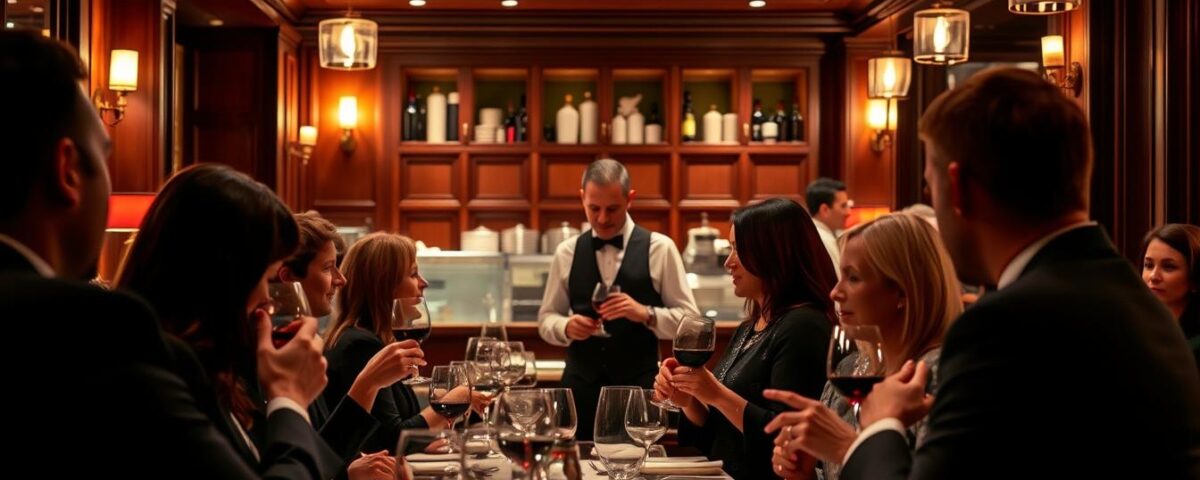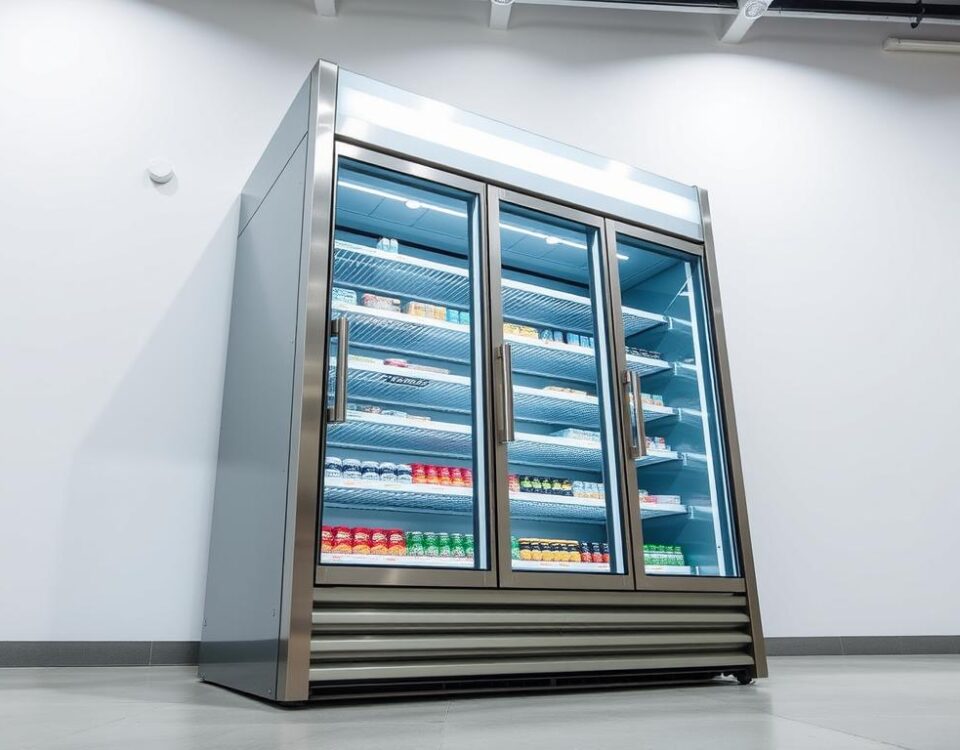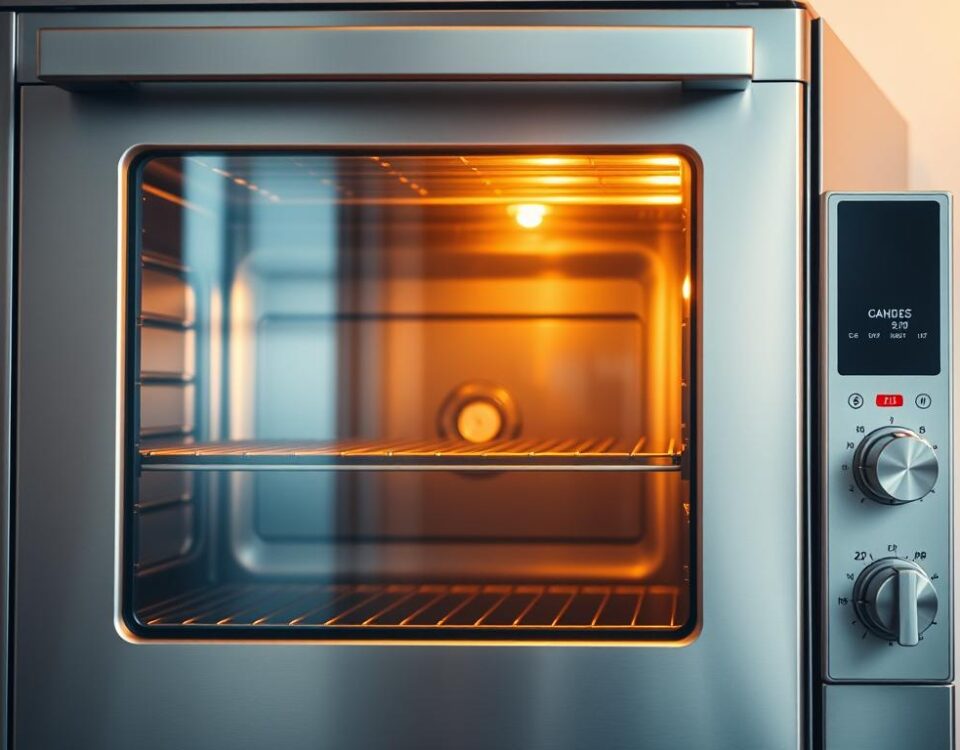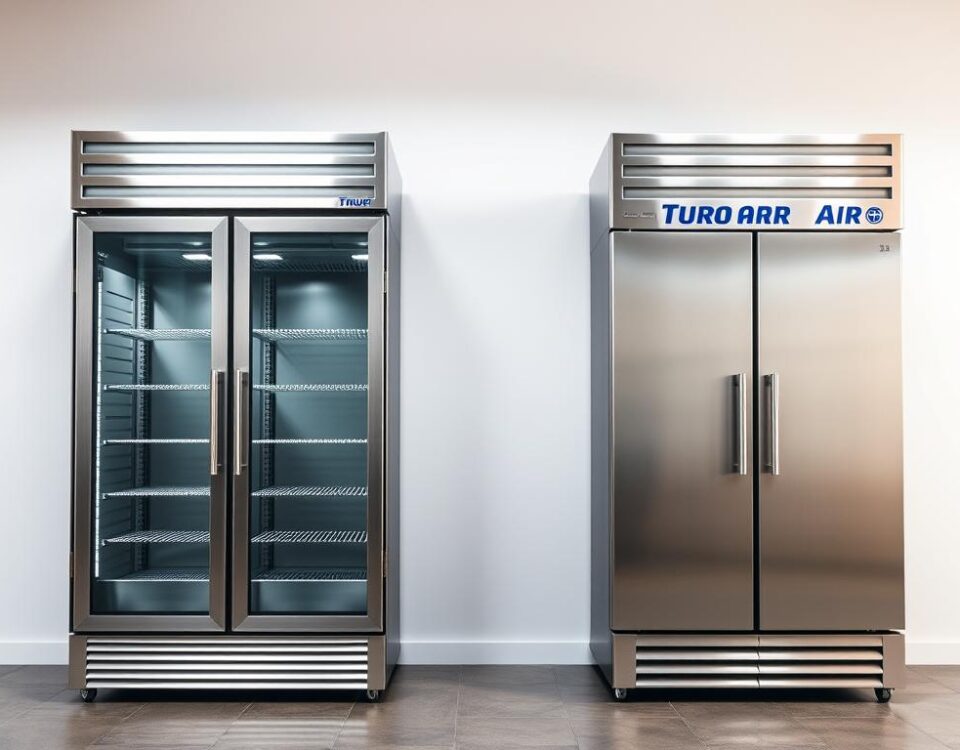
How to Master TikTok Marketing for Restaurants in 2025
August 5, 2025
The Profit-Boosting Power of Sourcing Food Locally in 2025
August 6, 2025I still remember my first visit to a fine dining establishment that left a lasting impression on me. The exceptional service, exquisite cuisine, and warm ambiance made me a loyal customer from the very start. But what really surprised me was that regulars like me often generate 65-80% of a restaurant’s profits.
This staggering statistic highlights the importance of customer retention in the competitive fine dining market. As someone who has studied this phenomenon, I’ve discovered that successful restaurants treat loyalty as their primary business model. So, what makes customers come back to their favorite restaurants?
The answer lies in creating memorable experiences that justify premium pricing. In this article, I’ll share the strategies that top restaurants use to keep their customers coming back.
Key Takeaways
- Regular customers generate a significant portion of a restaurant’s profits.
- Loyalty programs are crucial for long-term success in fine dining.
- Personalized service and exclusive experiences foster customer loyalty.
- Improving customer retention can boost profitability significantly.
- Creating emotional connections with customers is key to retention.
The Value of Customer Loyalty in Fine Dining
In the world of fine dining, customer loyalty is the cornerstone of a successful restaurant’s long-term profitability. As I’ve observed, upscale restaurants that prioritize customer retention tend to have higher profit margins. This is because retaining existing customers is often less costly than acquiring new ones.
Why Regulars Are the Backbone of Upscale Restaurants
Regular customers are the lifeblood of fine dining establishments. They not only provide consistent revenue but also become advocates for the restaurant, often recommending it to friends and family. Upscale restaurants that focus on creating personalized experiences for their regulars tend to see increased loyalty and retention. By making guests feel like they’re part of an exclusive club, restaurants can foster a deep sense of loyalty.
The Financial Impact of Repeat Customers
The financial benefits of customer loyalty in fine dining are substantial. Research shows that regulars typically spend 67% more in their 31st to 36th months as customers than they do in their first six months. This increase in spending, combined with the higher average order values from repeat customers, significantly boosts revenue. For upscale establishments, the lifetime value of a loyal customer can be extraordinary, with some customers spending $50,000 or more over a decade.
By understanding the value of customer loyalty and implementing strategies to retain customers, fine dining restaurants can ensure long-term success and profitability.
Creating Memorable First Impressions
A memorable first impression is the foundation upon which loyal customers are built in fine dining establishments. I’ve observed that upscale restaurants with exceptional retention rates all understand that the first impression begins before the guest even takes their first bite. It starts with the reservation process, the greeting at the door, and the initial tableside interaction.
Exceptional Service From the Moment Guests Arrive
The most successful fine dining establishments train their staff to provide exceptional service that feels both impeccably professional and genuinely warm. This balance makes guests feel both respected and welcomed. Some key aspects include:
- Personalized greetings that acknowledge regular customers
- Attentive service that anticipates guests’ needs
- Knowledgeable staff who can guide diners through the menu
By focusing on these elements, restaurants can create a positive first impression that sets the stage for a loyal customer base.
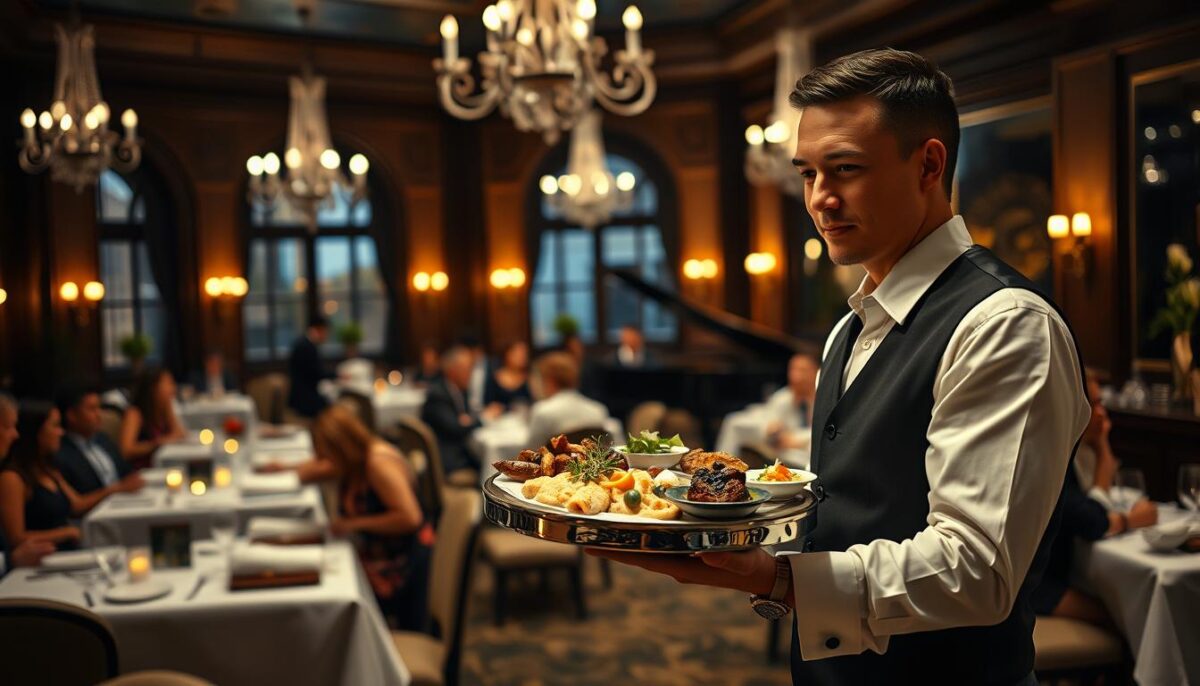
Ambiance That Encourages Return Visits
Creating an ambiance that encourages return visits involves careful attention to sensory details. From the perfect lighting that flatters guests to background music that enhances rather than competes with conversation, every element matters. Upscale restaurants leverage these details to create an atmosphere that makes customers want to return.
Some restaurants also use social media to extend the first impression beyond the physical space, creating Instagram-worthy plating and interior design that guests want to share, effectively turning diners into brand ambassadors.
Personalization: The Secret Weapon of Upscale Restaurant Customer Retention
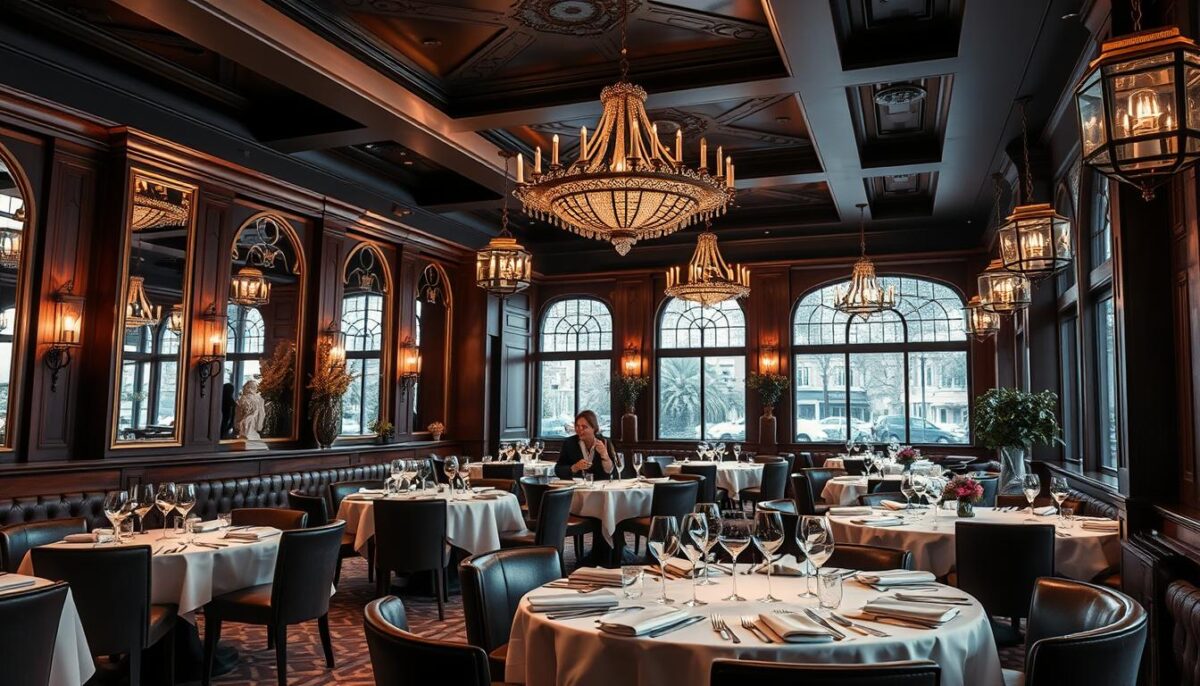
To stand out in the upscale dining scene, restaurants are turning to personalization as a retention strategy. By making customers feel truly known, upscale restaurants can significantly boost customer loyalty and retention.
Remembering Guest Preferences and Dietary Restrictions
The most sophisticated restaurant owners implement systems to track guest preferences with remarkable detail—from preferred tables and servers to favorite wines and even the pace at which they like their meal to progress. This level of personalization makes guests feel valued and understood, encouraging them to return.
Moreover, restaurant industry leaders in retention don’t just remember dietary restrictions; they anticipate them and proactively offer solutions before guests need to ask. This approach creates a sense of being genuinely cared for, further enhancing customer retention.
Personalized Communication Beyond the Dining Room
Personalized communication that extends beyond the dining room—such as birthday greetings, anniversary acknowledgments, or even congratulations on personal milestones mentioned during previous visits—creates emotional bonds that transcend the transactional nature of dining out. Email campaigns that reference previous visits and make personalized recommendations show dramatically higher engagement rates than generic messages.
I’ve observed that upscale restaurants with the highest customer retention rates use technology to enhance rather than replace the human touch, employing CRM systems that help staff deliver seemingly effortless personalization at scale.
Successful personalization in upscale dining requires a delicate balance—too little feels generic, while too much can feel intrusive. The key is to strike the right balance to create a truly personalized experience that fosters loyalty and encourages repeat visits.
Sophisticated Loyalty Programs That Drive Results
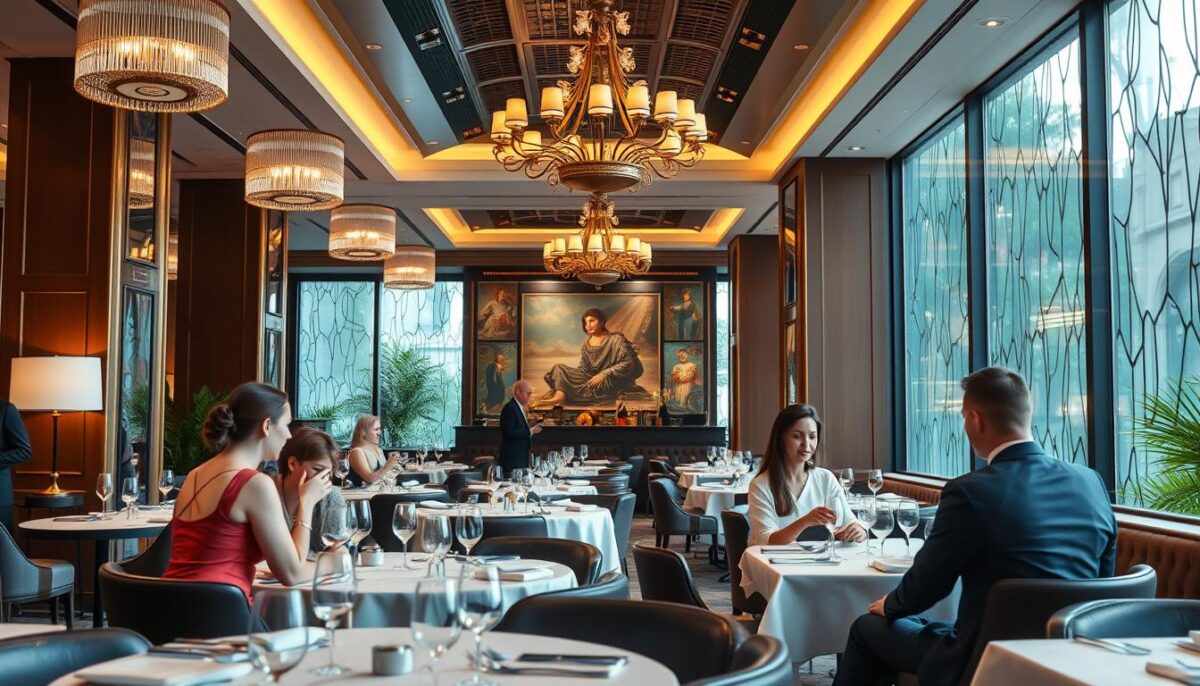
To stand out, luxury restaurants are adopting innovative loyalty strategies that go beyond traditional rewards. I’ve analyzed numerous upscale restaurant loyalty programs and found that the most effective ones are designed to feel like membership in an exclusive club.
The best loyalty programs in fine dining create emotional connections through unexpected moments of delight. For instance, a complimentary glass of champagne on an ordinary Tuesday can create more loyalty than a free dessert after ten visits.
Points-Based Systems That Feel Exclusive
Upscale restaurants that successfully retain customers understand that loyalty program tiers create powerful motivation. Guests increase their dining frequency to reach the next status level and its associated perks.
One effective way fine dining establishments leverage loyalty programs is by offering experiences that money can’t buy, such as private kitchen tours or exclusive tastings.
VIP Perks That Create Emotional Connections
Smart restaurants use loyalty programs to collect valuable feedback in a way that makes customers feel valued. Asking VIP members for input on new menu items creates both useful data and deeper engagement.
The most sophisticated loyalty programs integrate seamlessly with online reviews, encouraging satisfied customers to share their experiences while providing service recovery opportunities for those who had less than stellar visits.
By implementing such sophisticated loyalty programs, luxury restaurants can drive customer retention, encourage positive reviews, and ultimately increase their customer loyalty.
Leveraging Technology Without Sacrificing the Human Touch
I’ve observed that the most effective way to retain customers is by using technology to support, rather than replace, the personal service they receive. Upscale restaurants are now leveraging digital tools to enhance the dining experience without losing the human touch that makes their service exceptional.
The key to successful implementation lies in choosing technology that complements the personal interaction between staff and guests. For instance, custom mobile apps for premium dining experiences have shown remarkable results in retaining customers by offering genuine utility. When regular guests can book their favorite table with a single tap, reservation rates can increase by over 30%.
Custom Mobile Apps for Premium Dining Experiences
Custom mobile apps create a seamless experience for guests by allowing them to make reservations, place orders, and even provide feedback with ease. These apps can be designed to remember guest preferences, making it easier for restaurants to offer personalized service. By leveraging data from these interactions, restaurants can create targeted marketing campaigns that feel thoughtful rather than promotional.
Email campaigns that reference previous orders and suggest complementary experiences can dramatically increase engagement. This approach not only shows that the restaurant values its customers but also helps to build a stronger connection with them.
Reservation Systems That Remember Guest Preferences
Sophisticated reservation systems that track guest preferences have become essential tools for upscale restaurants focused on retention. These systems transform what could be transactional interactions into opportunities for relationship building. By remembering guest preferences across all touchpoints, restaurants can create a truly personalized experience that makes guests feel truly known.
Technology that enables staff to anticipate needs creates powerful loyalty moments. When a server knows it’s a guest’s birthday without being told or remembers their wine preferences from a previous visit, the impression of personalized care is amplified. This is the kind of service that fosters loyalty and encourages customers to return.
Email Marketing Strategies That Bring Diners Back
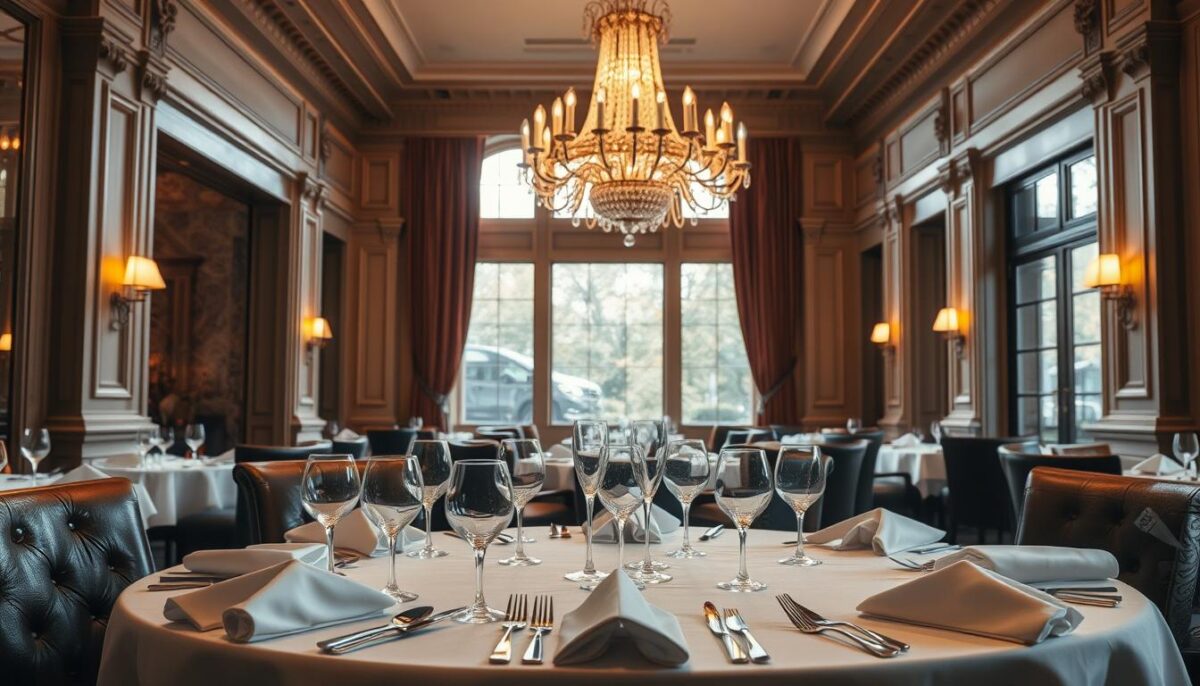
Effective email marketing is crucial for upscale restaurants aiming to retain customers and encourage repeat visits. I’ve analyzed data from numerous high-end dining establishments and discovered that successful email campaigns focus on building relationships rather than just promoting offers.
The key to a successful email marketing strategy lies in personalization and timeliness. For instance, sending a feedback email within 24 hours of a customer’s first visit can significantly enhance their dining experience. This approach not only provides valuable insights but also demonstrates the restaurant’s commitment to customer satisfaction.
First-Order Feedback and Follow-Up
Soliciting feedback from customers after their first order is a powerful way to show that their experience matters. By reaching out within 24 hours, restaurants can gather insights while creating a positive impression. This timely follow-up can lead to increased customer loyalty and retention.
Strategic Win-Back Campaigns for Lapsed Customers
Re-engaging lapsed customers requires a thoughtful approach. Instead of generic “we miss you” messages, restaurants can reference specific aspects of their previous visits. For example, mentioning a seasonal tasting menu they enjoyed can make the communication feel more personal and authentic.
By integrating email marketing with social media and loyalty programs, restaurants can create a cohesive communication strategy that reinforces their brand across all channels. This holistic approach can lead to increased customer retention and loyalty.
Menu Innovation and Consistency
Upscale restaurants understand that maintaining customer loyalty requires a delicate balance between menu consistency and innovation. As a regular at these establishments, I’ve observed that the most successful ones maintain a perfect balance between keeping their signature dishes and introducing new experiences.
The art of menu development for customer retention involves creating signature dishes that become destination items—preparations so distinctive and delicious that people make reservations specifically to experience them again. At the same time, seasonal menu changes create natural opportunities for re-engagement. I’ve seen restaurants dramatically increase retention by notifying past guests when their favorite seasonal dish returns, creating a compelling reason to book immediately.
Balancing Signature Dishes with Seasonal Offerings
The most effective menu strategies for retention include maintaining “greatest hits” while rotating seasonal specialties. This approach satisfies both the comfort-seeking and novelty-seeking aspects of upscale dining psychology. For instance, a restaurant might keep its popular signature dish on the menu year-round while introducing seasonal variations or limited-time offerings to keep the menu fresh and exciting.
- Signature dishes provide comfort and familiarity for regular customers.
- Seasonal offerings create excitement and anticipation for new experiences.
- A balanced menu caters to both repeat customers and new guests.
Creating Anticipation Through Limited-Time Experiences
Smart restaurant owners use limited-time offerings to create anticipation and urgency. Exclusive tasting menus or collaborative chef events give guests a specific reason to return within a defined time frame. I’ve found that restaurants with strong retention rates use their online ordering platforms to highlight both signature dishes and new offerings, making it easy for guests to reorder favorites while discovering new options.
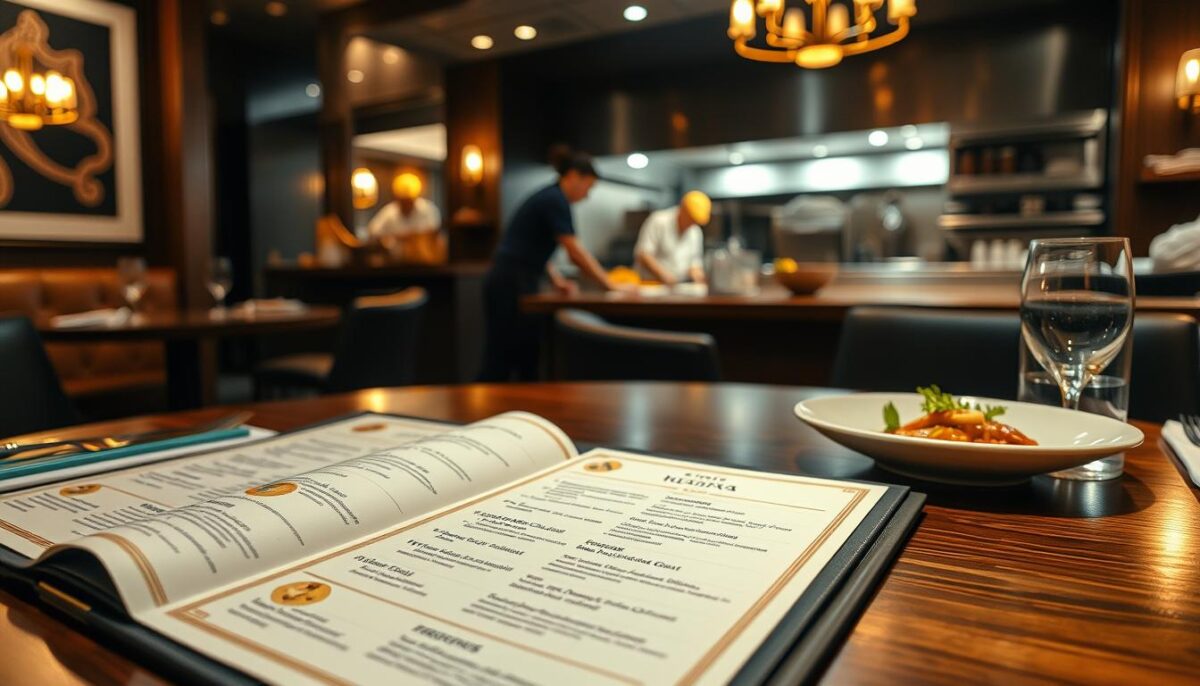
The way upscale restaurants describe menu items significantly impacts retention. Evocative, story-driven descriptions create emotional connections to dishes that transcend the ingredients themselves. Successful fine dining establishments take deliberate steps to document guest preferences and reactions to menu items, creating data that informs both future menu development and personalized recommendations during return visits.
Building Community Through Exclusive Events
In the upscale dining scene, exclusive events are not just about serving great food; they’re about creating a sense of belonging among customers. I’ve found that these events transform restaurants from mere places to eat into social communities centered around shared culinary experiences.
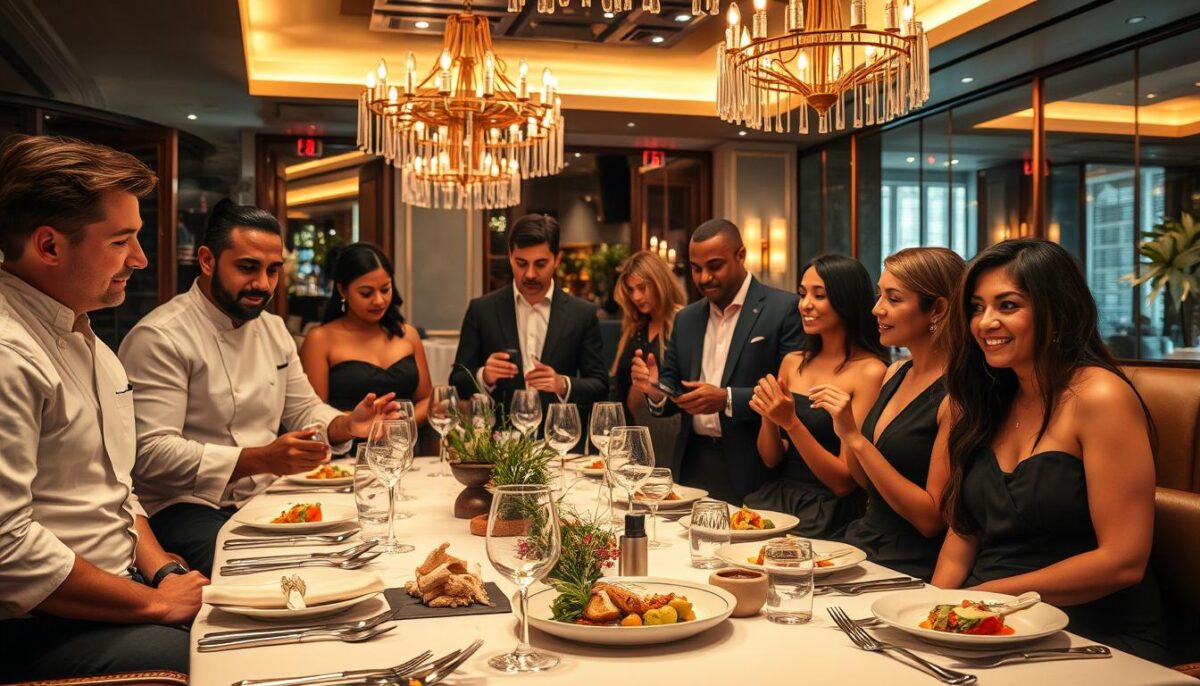
Chef’s Table Experiences and Tasting Menus
Chef’s table experiences offer unparalleled retention value—the intimate, behind-the-scenes nature of these events creates memorable moments that guests eagerly share through social media and personal recommendations. Exclusive tasting menus with limited seating create powerful FOMO (fear of missing out) that drives both immediate bookings and future reservations.
Private Dining and Special Occasion Recognition
The most successful upscale restaurants use private dining not just as a revenue stream but as a strategic retention tool—recognizing and enhancing special occasions creates emotional associations that bring guests back for future celebrations. The way these establishments recognize repeat customers during exclusive events significantly impacts whether those guests will continue to feel valued and return.
By leveraging guest feedback from exclusive events, smart restaurants can refine both their regular service and future special offerings. These intimate settings provide invaluable insights that reviews and standard feedback forms cannot match. Successful community-building strategies include creating opportunities for like-minded guests to connect with each other—wine clubs, cooking classes, and producer dinners foster relationships not just between the restaurant and guests, but among the guests themselves.
Conclusion: Investing in Long-Term Relationships, Not Just Transactions
Through my analysis, I’ve found that the most successful restaurants prioritize building emotional connections with their guests. This approach is fundamental to driving customer loyalty and retention in the upscale dining segment.
The restaurant industry continues to evolve, but the core principles of retention remain constant. Making guests feel valued, recognized, and eager to come back transcends trends and technology. By focusing on personalization, loyalty programs, and community building, restaurants can create a loyal customer base.
When analyzing the return on investment for retention strategies versus acquisition efforts, the numbers consistently show that nurturing existing customer relationships delivers significantly higher profits. The most effective email campaigns focus on relationship-building rather than transactions, reminding guests of memorable moments from past visits and creating anticipation for future experiences.
Upscale restaurants that maintain high retention rates understand that every touchpoint is an opportunity to strengthen the relationship with guests. By integrating all elements of retention strategies into a cohesive approach, restaurants can make guests feel they belong to something special. As I reflect on what truly makes guests come back time after time, it’s clear that while exceptional food is necessary, it’s the emotional connection to a restaurant that ultimately drives loyalty.
FAQ
How can I, as a fine dining establishment, encourage repeat business?
To drive repeat business, focus on delivering exceptional service, creating a memorable ambiance, and offering sophisticated loyalty programs that reward your loyal patrons.
What role does personalization play in retaining customers?
Personalization is key to making your guests feel valued. By remembering their preferences and dietary restrictions, you can tailor their experience to their needs, fostering a loyal following.
How can I leverage technology to enhance the dining experience without losing the human touch?
Implementing custom mobile apps and reservation systems that remember guest preferences can streamline the dining experience while maintaining a personal touch.
What are some effective email marketing strategies for bringing diners back?
To re-engage customers, consider first-order feedback and follow-up campaigns, as well as strategic win-back campaigns for lapsed customers, to keep your establishment top of mind.
How can I balance menu innovation with consistency?
By offering a mix of signature dishes and seasonal offerings, you can keep your menu fresh while maintaining consistency in quality and flavor profile.
What types of events can help build a sense of community among my customers?
Hosting exclusive events, such as chef’s table experiences and private dining, can create a sense of belonging among your patrons, encouraging loyalty and retention.
How can I measure the effectiveness of my loyalty programs?
To gauge the success of your loyalty programs, track metrics such as repeat customer rate and average order value, and adjust your strategies accordingly.
